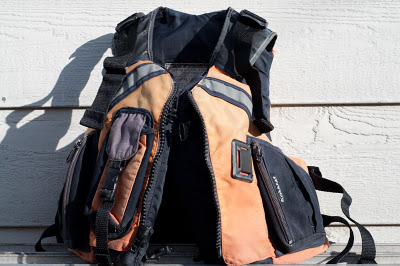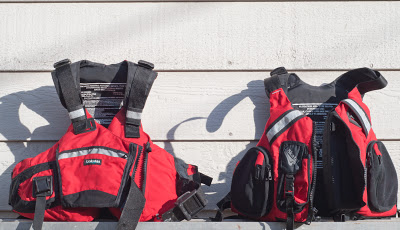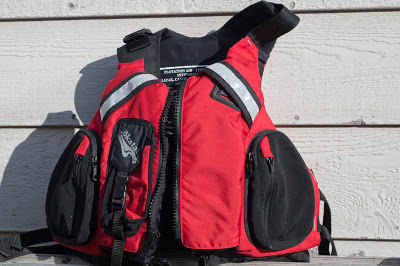Eventually, even the best gear wears out. After six years of heavy use and exposure to the elements, the fabric on Alec’s Kokatat MsFit Tour PFD was deteriorating, the retroreflective tape wasn’t retroreflecting, and the zipper tabs were gone from the pockets. Sadly, it was time to replace it.
 |
| Nothing lasts forever, not even a well-made PFD. |
We think pretty differently about some aspects of sea kayaking than we did six years ago, so this was an opportunity to consider whether a different PFD might be better. We no longer try to stash in them everything we could possibly need if we were separated from our boats and far from shore. In fact, we try to carry as little as possible for the conditions in which we’re paddling. No more flares, signal mirrors, hefty first aid kits, and excessive food and water. Like many of the coaches and expeditioners we interviewed for a Summer/Fall 2011 article in Adventure Kayak Magazine, we now consider it a hazard to be overburdened with gear, so we try to carry only the essentials and ensure that many items serve multiple purposes. If we need more than that, we’ve really screwed up.
But some things haven’t changed. Kokatat still offers terrific gear that’s made in the US and backed by excellent customer service. And the MsFit Tour is still the gold standard among PFDs–another observation we made while researching our article, “The Right Stuff.” So we decided to try out the Ronin Pro, an attractive vest with only one big pocket because it is designed for whitewater paddlers, and the new MsFit Tour.
 |
| The new Ronin Pro (left) and MsFit Tour (right). |
Alec was the only one of us in the market for a new PFD, so we got a small/medium Ronin Pro (the smallest size for that model) and a medium MsFit Tour. Both fit Alec, who is 5’4″ and 140 pounds; neither was small enough for Sharon, who is 5’1″ and 110 pounds and was therefore relegated to documenting the product testing.
 |
| The new MsFit Tour features a clever pouch above the lash tab so a knife can be tucked in. |
The new MsFit Tour boasts some improvements over the old one. The Gaia PVC-free foam feels comfy and broken in when it’s brand new, and the zipper tabs are larger and sturdier. The two side pockets are slightly larger and have an extra zippered pouch on them. The lash tab has been moved up and the fabric pouch on the shoulder extended down to provide an ingenious spot to tuck a knife. No more intimidating students or losing $60 knives!
 |
| The Ronin Pro features exceptionally large cut-outs around the arms. |
The Ronin Pro is also impressive. Like the MsFit, it is comfortable, solidly built and very adjustable. The cut-outs around the arms are larger, providing more freedom of movement, and there’s foam underneath the side straps, offering additional protection from side impacts.
 |
| Alec in the Ronin Pro. A paddler with a short torso fill find it especially bulky over the stomach. |
But the Ronin Pro has some down sides, at least for a paddler of Alec’s size. There’s a lot of additional foam on the chest because US Coast Guard regulations require Type III PFDs to have 15.5 pounds of buoyancy, and if you remove some foam from around the arms, you have to put it somewhere else. For a paddler with a short torso, this means extra foam on the stomach, where it gets in the way during self-rescues. In addition, it was impossible for him to wear a tow belt beneath it in the front.
A single pocket sounded like an attractive feature now that we carry less kit, but Alec discovered that he was always rooting around in it to find what he needed. Having three pockets, even if they aren’t full, is better for staying organized. And there was no place on the Ronin to carry a VHF radio.
 |
| The MsFit has ample room in the two side pockets for more than enough gear, a designated radio pocket, and a knife pouch. (No, that’s not the knife we’d actually carry.) |
The MsFit, by contrast, offered plenty of external pockets, that snazzy new knife pouch, and an internal pocket for a grease pencil and glasses. Even though that pocket can only be accessed by opening the zipper, internal buckles keep the PFD safely secured. The slimmer profile was better for rescues, too.
In the end, Alec chose to stick with the MsFit Tour. It’s simply better suited to sea kayakers, and especially for guides and instructors, who need to carry a certain amount of kit in an organized manner on their bodies.
Some day, we hope someone will figure out a way to add buoyancy without bulk. Or perhaps over time we’ll discover that we need to carry even less kit, or that PFDs need less foam. Until then, the MsFit seems to offers an excellent combination of fit, adjustability, workmanship, pocket configuration and other features for sea kayakers. Sometimes, like Dorothy, you go out looking for your heart’s desire only to find that you had it in your own back yard.








Nice review. I came to the same conclusion a couple of months ago when I bought my new MsFit Tour. I briefly considered the Ronin, but just couldn’t get beyond the single pocket issue. I also considered the Tour, but didn’t like the placement of the “vhf” pocket (dead center)as opposed to being right of center on the MsFit (I’m usually left of center guy, but I digress). Finally, given my height (5’7″) I felt that the MsFit fit better (I believe the torso length is a little shorter). Oh, I also have red–good choice 😉
Great comparison. Sharon, what do you wear for a pfd?
I’ve tried a number of lifejackets from Kokatat. I like a smaller number of pockets than most, I like a smaller, less bulky pfd. I had a retro-fit for years that I loved. It had one big pocket up front, and then a smaller one (left-of-center) similar to John Bs. It now looks like the one in the article. I have not found a replacement. I tried an orbit tour. It doesn’t have a good fit. It comes up and knocks me in the chops when I get hit face on with a wave. (a lot apparently) 🙂 I am a bit of a knucklehead, I don’t like to own the exact same gear as everyone else. I think it shows a lack of diversity in innovation, and divergent thinking in an area when this happens. I would say this has happened. There are not many good options for lifejackets for sea kayakers at the moment. I tried a number of lifejackets, and have not found one I liked. Your review is interesting, because unfortunately it is narrowing the field. I may end up with a Msfit too.
I’ve tried a number of lifejackets from Kokatat. I like a smaller number of pockets than most, I like a smaller, less bulky pfd. I had a retro-fit for years that I loved. It had one big pocket up front, and then a smaller one (left-of-center) similar to John Bs. It now looks like the one in the article. I have not found a replacement. I tried an orbit tour. It doesn’t have a good fit. It comes up and knocks me in the chops when I get hit face on with a wave. (a lot apparently) 🙂 I am a bit of a knucklehead, I don’t like to own the exact same gear as everyone else. I think it shows a lack of diversity in innovation, and divergent thinking in an area when this happens. I would say this has happened. There are not many good options for lifejackets for sea kayakers at the moment. I tried a number of lifejackets, and have not found one I liked. Your review is interesting, because unfortunately it is narrowing the field. I may end up with a Msfit too.
John, your correct the Msfit Tour is somewhat shorter that the Outfit Tour. The original idea was to make a pfd that fit women better ( hence the offering of the color plum). The interesting thing is that there are many men that benefit from a shorter pfd.
Keith, I hear you on not necessarily wanting the same gear as everyone else. As we mentioned in our review, I really wanted to go with the Ronin and was willing to reorganize how I carry my safety gear in my pfd. That said, there is a minimum amount of foam required by the coast guard, so with those fabulous arm cut outs comes an increase in foam towards the bottom of the pfd. Not as much of an issue for a paddler with a longer torso, but not good for someone like me with less torso real estate.
I wonder if some of the desire for an updated pfd has to do with a change in the type of paddling more paddlers are doing these days. We see more people out there, surfing, rock gardening,and playing in rough water. These activities are more like whitewater paddling and demand more mobility from our pfd’s. So it seems natural that we look for a lower a profile. As sea paddlers though, we do have needs that are different from whitewater paddlers: The ability to self-rescue, carry a tow belt, and store some basic safety items.
I would love to see a brand new pfd out there that would be like the P&H Delphin is to touring sea kayaks. Something of a specialty vest. A reasonable amount of pockets, a minimum amount of bulk, and allowance for easy range of motion. Right now I think that the MsFit is the best choice out there.
Alec
Alec,
Seems like the old range of lifejackets, actually had some more options. It seems more that the range has narrowed, rather than things have changed. Usually sales are the reason why things stop being made. The retrofit probably just didn’t sell as well, and they wanted to do something like it and designed the ronin. The only problem is, the ronin is a lot bigger than the retrofit.
Thanks for posting this.
PS, dudes having to wear anything named msfit is kinda emasculating no?…
I have had a MsFit for two years now, with reasonably good luck.
No, it has not affected my MoJo. However, sometimes my huge biceps get hung up on the front.
Check out the Palm Kaikoura for an excellent Guides Vest. Begins to address to problem of bulk with moulded foam inserts. Have been using this in New Zealand for over 2 years now and find I can do away with having any items cluttering my deck (bar a split).